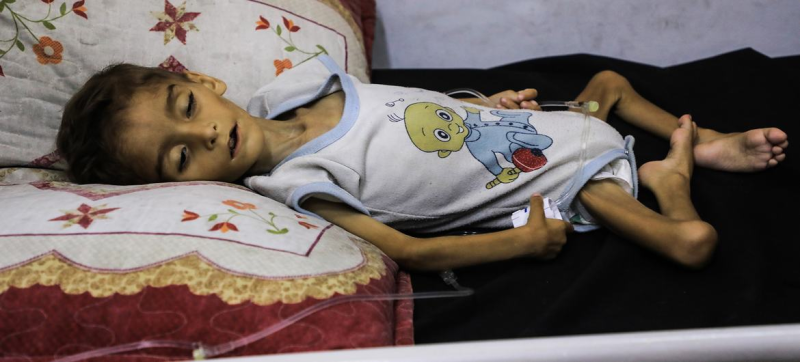- CA Yunus pays homage to Liberation War martyrs on Victory Day |
- Bangladesh capital market extends losing streak for second day |
- Bangladesh celebrates Victory Day Tuesday |
- 'Different govts presented history based on their own ideologies': JU VC |
Child Malnutrition in Gaza Hits Record High, UN Warns

A child suffering from malnutrition lies on a bed in the Patient Society Hospital in Gaza City .
Acute malnutrition among children in Gaza has reached the highest levels to date as hunger deepens in the enclave, the UN Office for the Coordination of Humanitarian Affairs (OCHA) reported on Thursday.
In July alone, nearly 12,000 children under five were identified as acutely malnourished out of 136,000 screened, according to aid partners.
Of these, more than 2,500 suffered from severe acute malnutrition, the most life-threatening form, and 40 were hospitalised in stabilisation centres.
The proportion of children with severe acute malnutrition is rising, OCHA said. In June and July, 18 per cent of acutely malnourished children had severe acute malnutrition, compared with 12 per cent between March and May.
Humanitarian access constraints are worsening the crisis. Last month, aid partners reached only 8,700 of the 290,000 children under five who require feeding and nutrition supplements, due to a severe shortage of lipid-based nutrient supplements entering Gaza.
OCHA called this a “dramatic collapse in the malnutrition prevention programme,” noting that between April and June, an average of 76,000 children—one quarter of those in need—were reached monthly.
Distribution of other key nutrition supplies has also sharply declined, affecting children, pregnant women, and breastfeeding mothers.
No shelter materials have entered Gaza since 2 March. Meanwhile, over one million shelter items and 2.3 million tents, tarps, and sealing-off materials remain stuck in Jordan and Egypt as Israeli authorities have not approved their entry.
The shelter crisis worsens, with many families living in overcrowded, unsafe conditions. Some have no shelter at all. In July, assessments of 44 displacement sites found 43 with families lacking shelter.
The situation deteriorates further due to ongoing bombardment, displacement orders, and insecurity, displacing families and disrupting humanitarian efforts.
OCHA reported that conditions remain largely unchanged since Israel announced a “tactical pause” to allow safe aid passage.
The UN agency reiterated that supplies remain insufficient amid immense needs, and UN convoys still face delivery challenges.
While fewer humanitarian movements are outright denied, approved missions often take hours, with some exceeding 18 hours.
On Wednesday, five out of 11 missions requiring coordination with Israeli authorities were facilitated, including food collection from the Kerem Shalom and Zikim crossings.
Four other missions faced impediments but were eventually completed, including fuel collection and transfer within Gaza.
One mission evacuated 15 children to Jordan with 42 companions, supported by the World Health Organization (WHO). However, over 14,800 patients in Gaza still urgently require specialised medical care.
OCHA also noted several trucks carrying food have entered Gaza in recent days.
The UN continues to monitor the situation, urging unimpeded and predictable humanitarian access, warning that without it, “time and resources are wasted, lives are lost, and the response cannot meet the scale of needs.”

